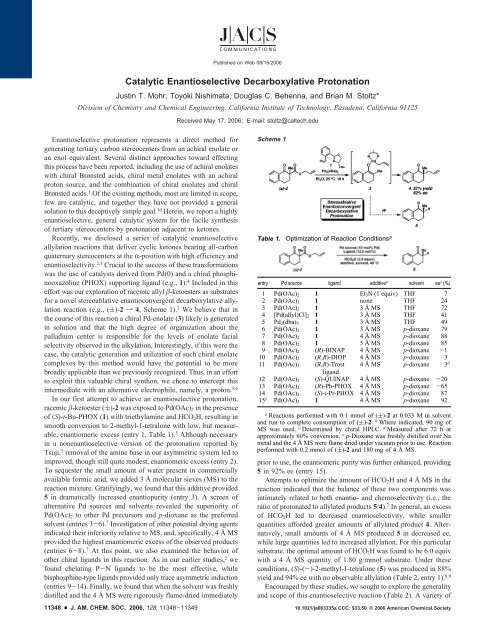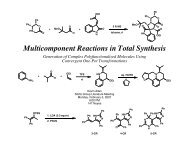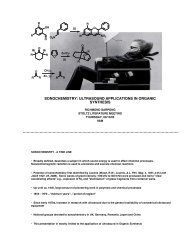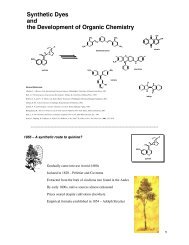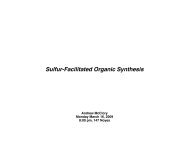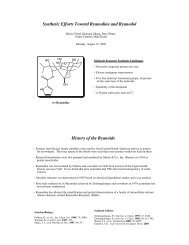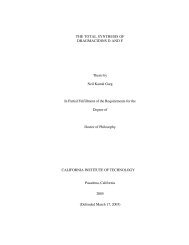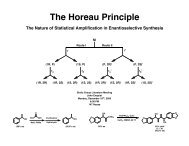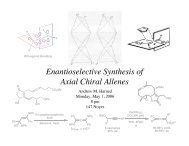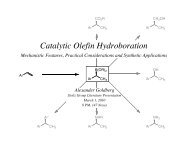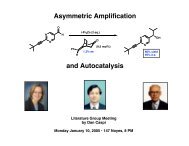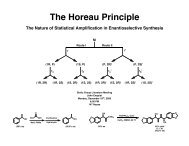Catalytic Enantioselective Decarboxylative ... - The Stoltz Group
Catalytic Enantioselective Decarboxylative ... - The Stoltz Group
Catalytic Enantioselective Decarboxylative ... - The Stoltz Group
You also want an ePaper? Increase the reach of your titles
YUMPU automatically turns print PDFs into web optimized ePapers that Google loves.
Published on Web 08/15/2006<strong>Catalytic</strong> <strong>Enantioselective</strong> <strong>Decarboxylative</strong> ProtonationJustin T. Mohr, Toyoki Nishimata, Douglas C. Behenna, and Brian M. <strong>Stoltz</strong>*DiVision of Chemistry and Chemical Engineering, California Institute of Technology, Pasadena, California 91125Received May 17, 2006; E-mail: stoltz@caltech.edu<strong>Enantioselective</strong> protonation represents a direct method forgenerating tertiary carbon stereocenters from an achiral enolate oran enol equivalent. Several distinct approaches toward effectingthis process have been reported, including the use of achiral enolateswith chiral Brønsted acids, chiral metal enolates with an achiralproton source, and the combination of chiral enolates and chiralBrønsted acids. 1 Of the existing methods, most are limited in scope,few are catalytic, and together they have not provided a generalsolution to this deceptively simple goal. 1d Herein, we report a highlyenantioselective, general catalytic system for the facile synthesisof tertiary stereocenters by protonation adjacent to ketones.Recently, we disclosed a series of catalytic enantioselectiveallylation reactions that deliver cyclic ketones bearing all-carbonquaternary stereocenters at the R-position with high efficiency andenantioselectivity. 2,3 Crucial to the success of these transformationswas the use of catalysts derived from Pd(0) and a chiral phosphinooxazoline(PHOX) supporting ligand (e.g., 1). 4 Included in thiseffort was our exploration of racemic allyl β-ketoesters as substratesfor a novel stereoablative enantioconvergent decarboxylative allylationreaction (e.g., (()-2 f 4, Scheme 1). 3 We believe that inthe course of this reaction a chiral Pd-enolate (3) likely is generatedin solution and that the high degree of organization about thepalladium center is responsible for the levels of enolate facialselectivity observed in the alkylation. Interestingly, if this were thecase, the catalytic generation and utilization of such chiral enolatecomplexes by this method would have the potential to be morebroadly applicable than we previously recognized. Thus, in an effortto exploit this valuable chiral synthon, we chose to intercept thisintermediate with an alternative electrophile, namely, a proton. 5,6In our first attempt to achieve an enantioselective protonation,racemic β-ketoester (()-2 was exposed to Pd(OAc) 2 in the presenceof (S)-t-Bu-PHOX (1) with triethylamine and HCO 2 H, resulting insmooth conversion to 2-methyl-1-tetralone with low, but measurable,enantiomeric excess (entry 1, Table 1). 5 Although necessaryin a nonenantioselective version of the protonation reported byTsuji, 5 removal of the amine base in our asymmetric system led toimproved, though still quite modest, enantiomeric excess (entry 2).To sequester the small amount of water present in commerciallyavailable formic acid, we added 3 Å molecular sieves (MS) to thereaction mixture. Gratifyingly, we found that this additive provided5 in dramatically increased enantiopurity (entry 3). A screen ofalternative Pd sources and solvents revealed the superiority ofPd(OAc) 2 to other Pd precursors and p-dioxane as the preferredsolvent (entries 3-6). 7 Investigation of other potential drying agentsindicated their inferiority relative to MS, and, specifically,4ÅMSprovided the highest enantiomeric excess of the observed products(entries 6-8). 7 At this point, we also examined the behavior ofother chiral ligands in this reaction. As in our earlier studies, 2 wefound chelating P-N ligands to be the most effective, whilebisphosphine-type ligands provided only trace asymmetric induction(entries 9-14). Finally, we found that when the solvent was freshlydistilled and the 4ÅMSwere rigorously flame-dried immediatelyScheme 1Table 1.Optimization of Reaction Conditions aentry Pd source ligand additive b solvent ee c (%)1 Pd(OAc) 2 1 Et 3N (1 equiv) THF 72 Pd(OAc) 2 1 none THF 243 Pd(OAc) 2 1 3 Å MS THF 724 [Pd(allyl)Cl] 2 1 3 Å MS THF 415 Pd 2(dba) 3 1 3 Å MS THF 496 Pd(OAc) 2 1 3ÅMS p-dioxane 797 Pd(OAc) 2 1 4ÅMS p-dioxane 888 Pd(OAc) 2 1 5ÅMS p-dioxane 859 Pd(OAc) 2 (R)-BINAP 4 Å MS p-dioxane -110 Pd(OAc) 2 (R,R)-DIOP 4 Å MS p-dioxane 311 Pd(OAc) 2 (R,R)-Trost 4ÅMS p-dioxane 3 dligand12 Pd(OAc) 2 (S)-QUINAP 4 Å MS p-dioxane -2013 Pd(OAc) 2 (R)-Ph-PHOX 4 Å MS p-dioxane -6514 Pd(OAc) 2 (S)-i-Pr-PHOX 4 Å MS p-dioxane 8715 e Pd(OAc) 2 1 4ÅMS p-dioxane 92a Reactions performed with 0.1 mmol of (()-2 at 0.033 M in solventand run to complete consumption of (()-2. b Where indicated, 90 mg ofMS was used. c Determined by chiral HPLC. d Measured after 72 h atapproximately 60% conversion. e p-Dioxane was freshly distilled over Nametal and the4ÅMSwere flame dried under vacuum prior to use. Reactionperformed with 0.2 mmol of (()-2 and 180 mg of 4 Å MS.prior to use, the enantiomeric purity was further enhanced, providing5 in 92% ee (entry 15).Attempts to optimize the amount of HCO 2 Hand4ÅMSinthereaction indicated that the balance of these two components wasintimately related to both enantio- and chemoselectivity (i.e., theratio of protonated to allylated products 5/4). 7 In general, an excessof HCO 2 H led to decreased enantioselectivity, while smallerquantities afforded greater amounts of allylated product 4. Alternatively,small amounts of 4ÅMSproduced 5 in decreased ee,while large quantities led to increased allylation. For this particularsubstrate, the optimal amount of HCO 2 H was found to be 6.0 equivwitha4ÅMSquantity of 1.80 g/mmol substrate. Under theseconditions, (S)-(-)-2-methyl-1-tetralone (5) was produced in 88%yield and 94% ee with no observable allylation (Table 2, entry 1). 8,9Encouraged by these studies, we sought to explore the generalityand scope of this enantioselective reaction (Table 2). A variety of11348 9 J. AM. CHEM. SOC. 2006, 128, 11348-11349 10.1021/ja063335a CCC: $33.50 © 2006 American Chemical Society
Table 2.Enantioconvergent <strong>Decarboxylative</strong> ProtonationsCOMMUNICATIONSasymmetric alkylation methodology that delivers quaternary stereocentersfrom the same starting materials via catalytic enantioselectiveallylation. Additional explorations of the scope, mechanism,and applications of these technologies are currently underway. 10Acknowledgment. <strong>The</strong> authors thank Eli Lilly (predoctoralfellowship to J.T.M.), Sankyo Co., Ltd. (financial support of T.N.),<strong>The</strong> Fannie and John Hertz Foundation (predoctoral fellowship toD.C.B.), Merck, Amgen, Johnson & Johnson, Bristol-Myers Squibb,and the Dreyfus Foundation for generous funding.Supporting Information Available: Experimental details. Thismaterial is available free of charge via the Internet at http://pubs.acs.org.a Isolated yield from the reaction of 0.3 mmol of substrate at 0.033 Min p-dioxane with 10 mol % Pd(OAc) 2, 12.5 mol % (S)-t-Bu-PHOX, 5-8equiv HCO 2H, and 405-810mgof4ÅMSat40°C (ref 7). b Determinedby chiral HPLC or GC; where noted, the absolute configuration wasdetermined by comparing the sign of optical rotation to literature values(ref 7). c Reaction performed with 5 mol % Pd(OAc) 2 and 6.25 mol %(S)-t-Bu-PHOX. d GC yield using tridecane as internal standard. e Reactionperformed at 35 °C.substitutions is tolerated at the ketone R-position (entries 1-3) andvarious positions about the aromatic ring (entries 4-8) of 1-tetralonederivatives. Enantioenriched (S)-(+)-2-methyl-1-indanone can alsobe produced from the corresponding β-ketoester (entry 9). Additionally,monocyclic compounds (entries 10-13) and a heterocycle(entry 14) were easily accessed under similar reactionconditions. <strong>The</strong> absolute configuration of a number of products wasestablished by a comparison of the observed sign of optical rotationto literature values (entries 1-3, 9, 11, and 12). 7 Interestingly, fusedaromatic substrates (i.e., tetralones and indanones) lead to productsin the opposite enantiomeric series compared to that of thecyclohexanone cases (cf. entries 1-3 and 9 to entries 11 and 12).<strong>The</strong>se results are in contrast to the consistent enantiofacial selectivityobserved across multiple substrate types in our asymmetricallylation chemistry and suggest stark differences in their correspondingmechanisms. 2,3In conclusion, a novel system for the enantioconvergent decarboxylativeprotonation of racemic β-ketoesters has been developed.<strong>The</strong> reaction tolerates a variety of substitution and functionalityand delivers products of high enantiopurity in excellent yield. <strong>The</strong>enantioinduction in the observed protonated products is consistentwith the intermediacy of an enolate that is intimately associated tothe chiral Pd complex. This, in turn, substantiates our initialhypothesis concerning the nature of the reactive intermediate 3 andopens the door to further applications. <strong>The</strong> process capitalizes onthe availability and unique reactivity of racemic R-substituted allylβ-ketoesters,which are employed directly in the catalytic enantioselectiveprocess and deliver valuable tertiary-substituted productsin highly enantioenriched form. In general, the overall process (substratesynthesis and use) represents a catalytic enantioselective variantof classic alkylation/decarboxylation sequences (e.g., acetoaceticester synthesis, cf. eqs 1 and 2). Furthermore, the asymmetric protonationdescribed here serves to complement our recently developedReferences(1) For reviews of enantioselective protonation, see: (a) Duhamel, L.;Duhamel, P.; Plaquevent, J.-C. Tetrahedron: Asymmetry 2004, 15, 3653-3691. (b) Yanagisawa, A.; Yamamoto, H. In ComprehensiVe AsymmetricCatalysis; Jacobsen, E. N., Pfaltz, A., Yamamoto, H., Eds.; Springer: NewYork, 1999; Vol. 3, pp 1295-1306. (c) Yanagisawa, A.; Yamamoto, H.In ComprehensiVe Asymmetric Catalysis; Jacobsen, E. N., Pfaltz, A.,Yamamoto, H., Eds.; Springer: New York, 2004; Supplement 2, pp 125-132. (d) Fehr, C. Angew. Chem., Int. Ed. Engl. 1996, 35, 2566-2587.(2) Behenna, D. C.; <strong>Stoltz</strong>, B. M. J. Am. Chem. Soc. 2004, 126, 15044-15045.(3) Mohr, J. T.; Behenna, D. C.; Harned, A. M.; <strong>Stoltz</strong>, B. M. Angew. Chem.,Int. Ed. 2005, 44, 6924-6927.(4) For the development of phosphinooxazoline ligands, see: (a) Helmchen,G.; Pfaltz, A. Acc. Chem. Res. 2000, 33, 336-345. (b) Williams, J. M. J.Synlett 1996, 705-710 and references therein.(5) A nonenantioselective decarboxylative protonation has been reported byTsuji, see: (a) Tsuji, J.; Nisar, M.; Shimizu, I. J. Org. Chem. 1985, 50,3416-3417. (b) Mandai, T.; Imaji, M.; Takada, H.; Kawata, M.; Nokami,J.; Tsuji, J. J. Org. Chem. 1989, 54, 5395-5397.(6) To our knowledge, there are three other groups that have reported relatedPd-catalyzed systems that produce similar enantioenriched products, see:(a) Hénin, F.; Muzart, J. Tetrahedron: Asymmetry 1992, 3, 1161-1164.(b) Aboulhoda, S. J.; Hénin, F.; Muzart, J.; Thorey, C.; Behnen, W.;Martens, J.; Mehler, T. Tetrahedron: Asymmetry 1994, 5, 1321-1326.(c) Aboulhoda, S. J.; Létinois, S.; Wilken, J.; Reiners, I.; Hénin, F.;Martens, J.; Muzart, J. Tetrahedron: Asymmetry 1995, 6, 1865-1868.(d) Baur, M. A.; Riahi, A.; Hénin, F.; Muzart, J. Tetrahedron: Asymmetry2003, 14, 2755-2761. (e) Sugiura, M.; Nakai, T. Angew. Chem., Int. Ed.Engl. 1997, 36, 2366-2368. (f) Hamashima, Y.; Somei, H.; Shimura,Y.; Tamura, T.; Sodeoka, M. Org. Lett. 2004, 6, 1861-1864.(7) See the Supporting Information for details.(8) Despite extensive experimentation to verify the origin of the protonobserved in the products (i.e., 5), we have maximally observed 35%D-incorporation when using HCO 2D and rigorously dried 4 Å MS. Bycontrast, under otherwise identical conditions,


